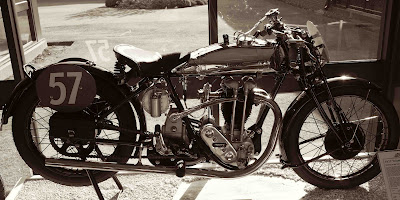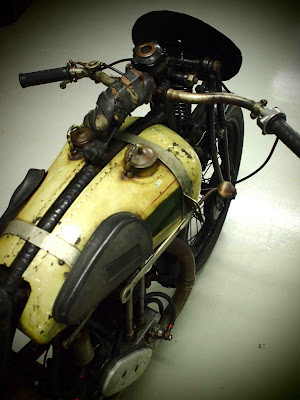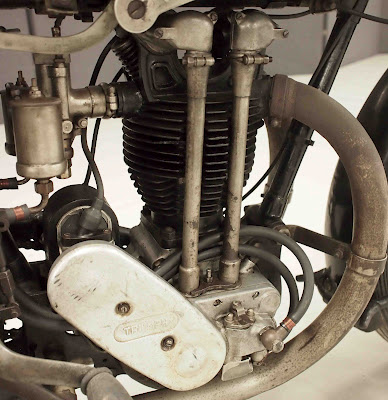(Before It's News)
It’s not often one stumbles across a Vintage race machine with an interesting history, and even more rare when it appears with a delicious patina – ‘dans son jus’ – which may be from the era it was originally raced (in this case, the late 1920s), or evidence of a long career, post-restoration, in the modern era. Unless we know the provenance of this remarkable 1927 Triumph ex-Works TT racer, we’ll have to settle on enjoying the machine as it sits; much evidence of use, of care, and of battle.
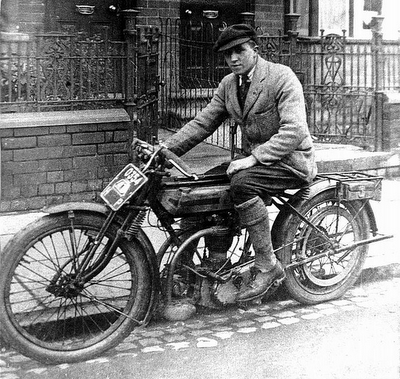 |
| Triumph employee Wilmot Evans testing a ‘Ricardo’ 4-valve model in 1924 |
Triumph motorcycles went through a shift in 1926/7, the end of the ‘Ricardo’ era, when their hottest sports machine was the 4-Valve design dating back to 1921, penned by Sir Harry Ricardo, a true pioneer of internal combustion science, the discoverer of ‘squish’ effects, and the man who brought scientific principles to the blooming motor vehicle industry. His four-valve design brought twin advantages of better gas flow through the engine, generating far more power than sidevalve designs, and increasing reliability by lightening the valve train components. As high-stress metallurgy was very much a developing art, valve and spring breakage vexed every motorcyclist of the ‘Teens and Twenties; the Ricardo design, with lighter components doing less work, was a great step forward in reliability.
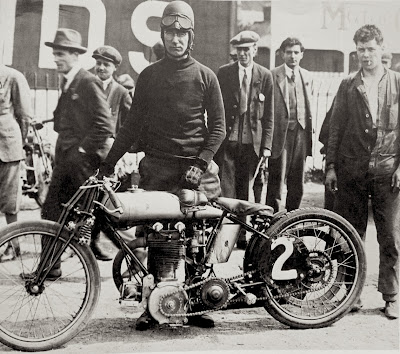 |
| ‘Vic’ Horsman testing his new Triumph ohv design at Brooklands |
In the 1920s, a seven-year design life was rare for one engine configuration, and noted Brooklands tuner/racer ‘Vic’ Horsman was hired by Triumph to update their road and racing range. The results of his work was a new flagship model, a 500cc two-valve ohv design, with enclosed pushrods but open rockers, and a long stroke of 80x99mm. Horsman himself tested the machine at Brooklands, finding it an improvement over the Ricardo, and Triumph combined a new product launch in 1927 with the fielding of its own team of riders on specially tuned ‘TT’ models. Horsman, ever the tuner himself, sponsored his own small team of riders, with specially equipped ‘TT’ racers, which appeared in the Isle of Man TT and Ulster GP that year, as well as many Continental races, typically under the helm of rider Tommy Simister, who made 3rd place in that year’s Isle of Man Senior TT.
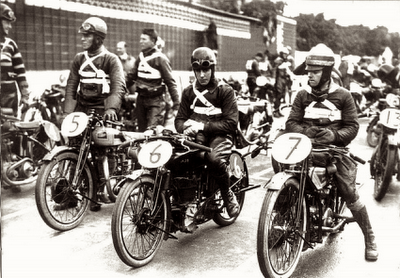 |
| Lining up at the start of the 1927 Isle of Man TT; from left, Tommy Span (Sunbeam), Wilmot Evans (Triumph), LH Davenport (AJS), and RF Parkinson (Douglas) |
The factory fielded six machines at the TT, while Tommy Simister was privately entered by Horsman. Clearly, the designer’s machine was the fastest of all the Triumphs; after falling off at Creg-ny-Baa corner and the machine landing atop him, Simister sprang back on the bike and carried on, kicking a bent footrest straight as he raced. While later nearly running out of corner again, Simister went on to finish 3rd, covering the 264 miles at an average of 65.75mph. The next Triumph was Hugh Tyrell Smith at 13th. Alec Bennett on his Norton ohc CS1 won the race at and average 68.41mph, followed by Jimmie Simpson (who would soon race for Norton as well) on a New Hudson, at 66.02. ‘Pushrod’ engines were still competitive in 1927, but Simpson’s win told the future; 1930 was the last time the Isle of Man Senior TT was won by a pushrod engine (the Rudge of Wal Handley @74.24mph) – after that it was all ‘cammies’, all the time.

The remarkable machine pictured here will be auctioned at the Bonhams Stafford sale, April 29th. It is believed one of the six ‘Works’ TT Triumphs of 1927, although it isn’t currently known how it fared in the race, nor whom was the rider. It bears all the features of the factory racers; the soldered-up pannier petrol tanks, the large diameter front brake, the cylindrical oil tank. A twin-float Amac racing carburetor and Lucas racing magneto keep the engine spinning, although the gearchange has been updated to a positive-stop foot mechanism…while the hand change lever remains tankside – curious.
From the evidence, this 1927 Triumph TT racer has led a long and active racing career, and whether the paint is as per the ’27 race, or a much later restoration now suitably, and beautifully, softened by experience, matters little. The bike is perfect as it sits, and will make a fantastic addition to anyone’s collection.
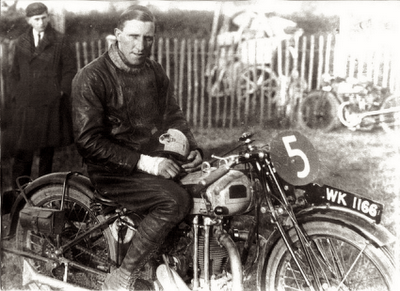 |
| Wilmot Evans again, at the 1927 Isle of Man Senior TT |
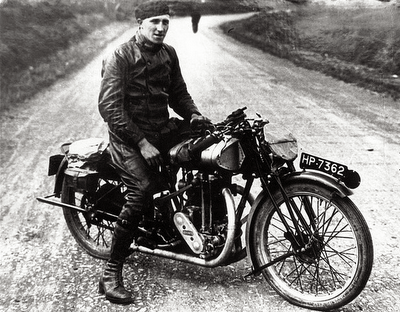 |
| Wilmot Evans at the 1927 Ulster GP, which he did not finish due to magneto trouble |
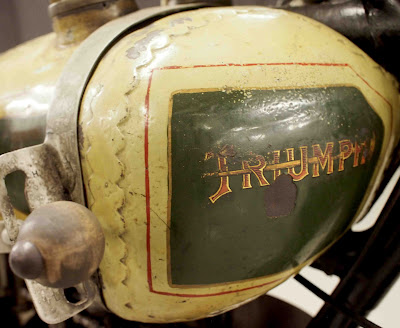 |
| Triumphs until 1928 were generally painted in shades of green… |
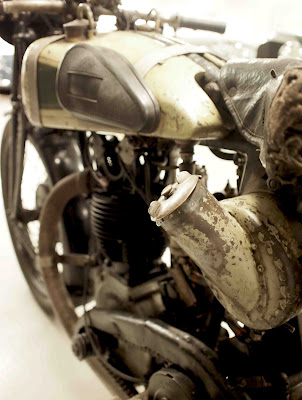 |
| The cylindrical oil tank is clearly visible… |
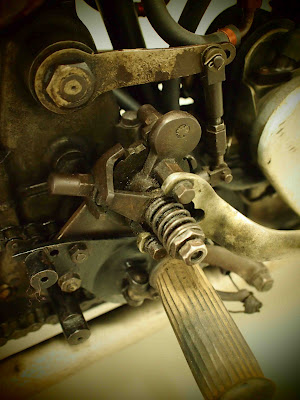 |
| …as is the footchange conversion, although the handchange lever is still present. |
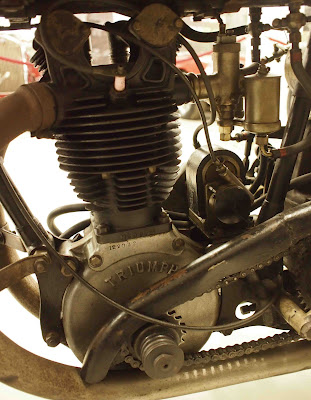 |
| The primary drive, showing the Amac TT carb and Lucas racing magneto |
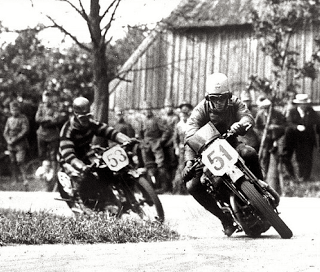 |
| Tommy Simister racing at the 1928 Dutch TT (with Tommy Spann following on his Sunbeam) |
The World’s #1 Vintage Motorcycle Site
Read more at The Vintagent
Source:








